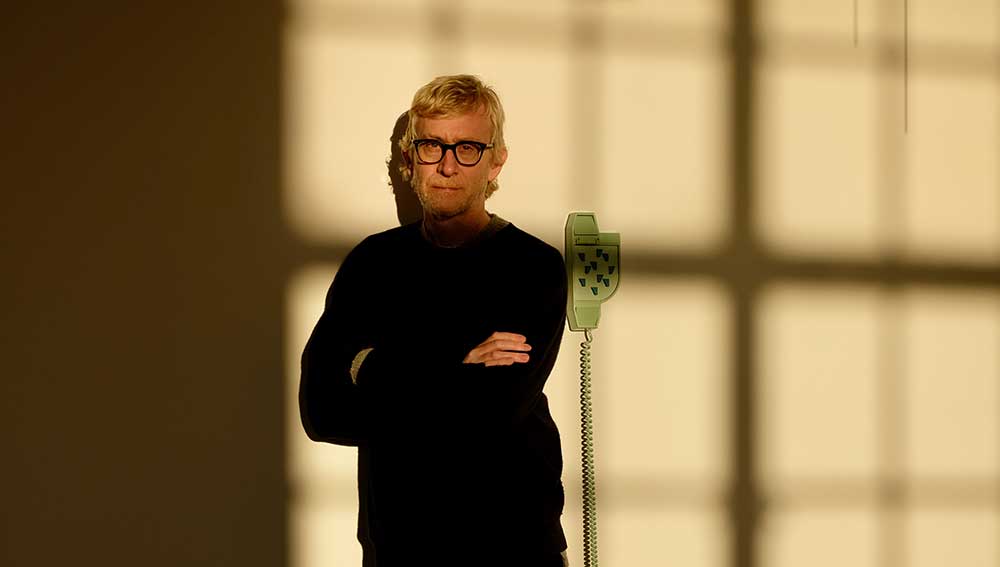
Martin Boyce. Photo courtesy Fruitmarket, Edinburgh.
by VERONICA SIMPSON
When Martin Boyce (b1967, Hamilton, Scotland) won the Turner Prize in 2011, his Tate Britain installation was described in the Guardian as “quietly atmospheric, lyrically autumnal” and evocative of “a melancholy urban park”. With Before Behind Between Above Below, his current retrospective at Edinburgh’s Fruitmarket gallery and his first major UK show for some time, there are plenty of quietly atmospheric, as well as lyrically autumnal moments. There is less of the urban park, though the presence of urban materials, forms and textures, natural and artificial, institutional and domestic, is woven throughout the three gallery spaces in combinations that are sometimes surreal, sublime, spooky or familiar, or all of the above.
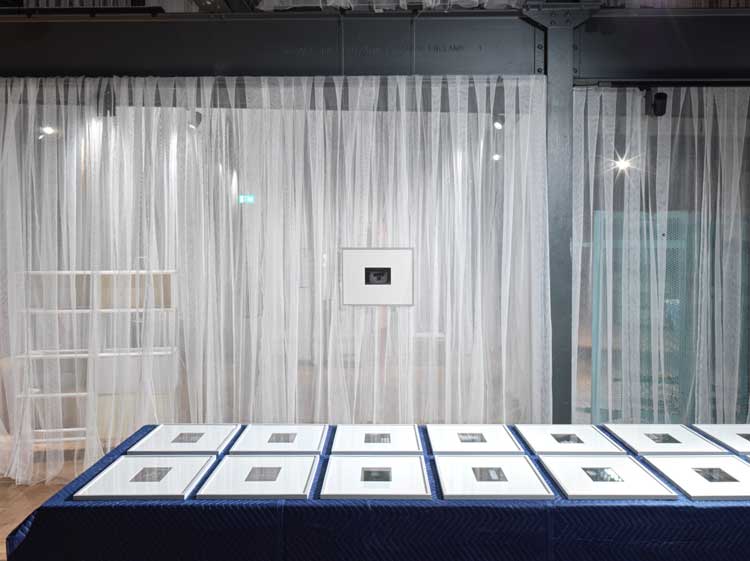
Martin Boyce. Spook School, 2016. Installation view, Fruitmarket Warehouse, 2024. Photo: Stefan Altenburger.
There is, as it happens, a work called Spook School (2016): an assortment of black-and-white photographs of the scorched carcass of Charles Rennie Mackintosh’s Glasgow School of Art building, after a fire in 2014, when much of the original structure was still salvageable, and before a second fire in 2018, which devastated the almost completed, refurbished building. Boyce studied for his BA and MFA at Glasgow School of Art, so this view inside the remnants must have been particularly moving. They are laid out on one long table – like some kind of crime scene investigation, according to Jonathan Jones in the Guardian. That is not Boyce’s intention, as he explains below.
Boyce’s show launches a year of celebratory exhibitions for this landmark Edinburgh gallery’s 50th anniversary. He has a long association with the institution: he first exhibited at Fruitmarket in 1999, taking part in a series of exhibitions titled Visions for the Future, which – accurately – hailed him as a talent to watch. There are works from all the decades of his career, including traces of the concrete trees that made such an impact in his Turner Prize show inspired by the modernist/cubist trees designed in 1925 by Joël and Jan Martel for the 1925 International Exhibition of Modern Decorative and Industrial Arts in Paris. What Boyce wants to draw our attention to here, however, is the evolution of his designs from the Martels’ conception. A sculptural table takes us through a process of drawings, models and maquettes that led to a multitude of other works that borrow from their geometries. including some gently crinkled fallen leaves made of paper, and a distinctive alphabet that crops up frequently, in words or loose letters, across this show.
Studio spoke to the artist in his Glasgow base, on Zoom.
Veronica Simpson: How did you approach this Fruitmarket exhibition, now that there is a new industrial-style “warehouse” gallery, along with the more familiar, white cube spaces.
Martin Boyce: When I received the email invitation from Fiona [Bradley, Fruitmarket’s director], I was in an art storage facility where the Modern Institute gallery in Glasgow stores its work – two huge warehouses out near Glasgow airport. I’m there quite often, sometimes having to condition-check the works. And it’s always a kind of amazing experience when you’re walking past 5-metre-high shelves of crates, with your name on some of them. And it gets you thinking about where a lot of art really spends its life. I was relating that to memory and, I guess, the subconscious perhaps, or the unconscious. So, that was one of the first things. For a long time, something I’d wanted to do, and never quite got round to, was to show work in some kind of in-between state – between storage and being presented to the public. I’ve always thought that could be an interesting thing. And, of course, the warehouse space was perfect for that. It has that backstage feel.
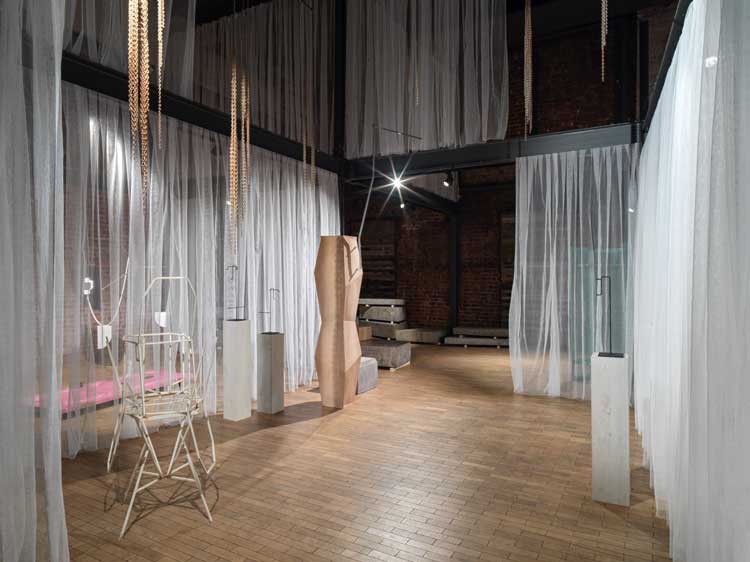
Martin Boyce. Before Behind Between Above Below. Installation view, Fruitmarket Warehouse, 2024. Photo: Stefan Altenburger.
VS: In there you have displayed some haunting photographs of the fire-damaged Mackintosh building at Glasgow Art School. Jonathan Jones, in his review in the Guardian, said it made him think of a crime scene investigation.
MB: I made those photographs of the art school in between the two fires. I was invited to have a tour as the school was being renovated. It was two separate visits. I took those photographs never thinking they would become a work. Laying it on that table was more about the idea of them being condition-checked. They’re on packing blankets, a very common material in an art warehouse space. So, for me it was very much about either they were coming out of the crates, and they were about to be displayed, or they had been displayed and were being checked before going back in the crates. It was really interesting to read this other interpretation of the work.
VS: Well, you studied at GSA and still live in Glasgow, so it’s easy to imagine you have a very personal relationship to that site and the trauma of not one but two fires there.
MB: No, it was more about creating a space that would play with the language of storage and maybe works being looked at privately before going on to display. That was the feel I wanted to go for. And there are also works that kind of deal with or play with the idea of an in-between space. For example, there’s three mask stands – metal armatures – that look like something should be displayed on them. The armature is the sculpture, and they’re on plinths (representing) these slightly liminal or in-between states. There’s also a door that lies horizontally and a mobile that hangs above it, featuring a telephone that is dangling above the door, as if the door is in conversation with the phone, though the phone is off the hook.
There’s also a wall panel that has a packing blanket half covering it. I wanted to conjure the idea that you’re in a space and looking at things in a way you wouldn’t normally see. There is a theatricality, though it’s not at all about trying to create an accurate representation of that (storage) space.
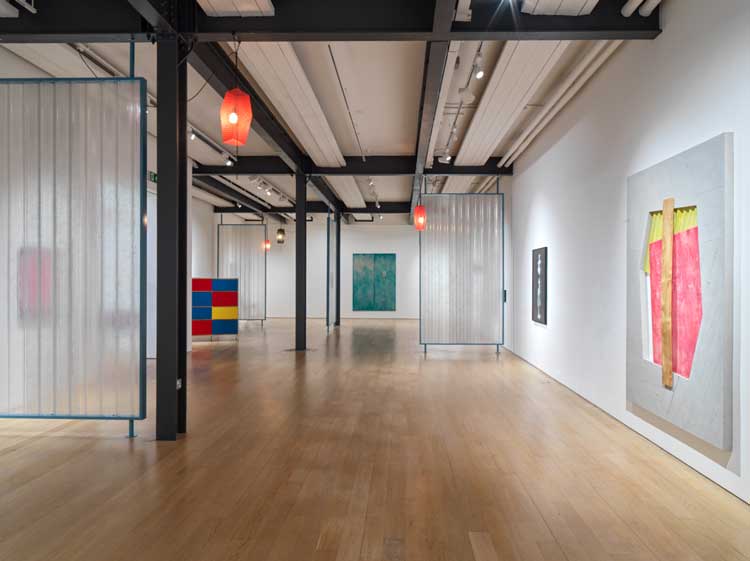
Martin Boyce. Before Behind Between Above Below. Installation view, Fruitmarket, 2024. Photo: Stefan Altenburger.
VS: Jones’s review proposed that you were showing us a vision of hell in that room, that transformed into one of heaven in the upper gallery, but it is hard at the Fruitmarket to be sure at which point any visitor will start. Were you trying to take people on a specific emotional journey?
MB: No, I never thought if it in that way … No, each room serves a particular function. I suppose I’m playing with the classic format of an exhibition. Although I consider myself a sculptor primarily, over the years I’ve also made quite a lot of wall-based works, which are usually quite sculptural. I’ve never had an exhibition where I’ve drawn on a large number of wall-based works from a large span of time. But I also wanted, when it’s necessary or interesting to adapt a space, to do something that affects the space as well. So, in the downstairs gallery I had already started to plan these screens that would divide the space a little bit, to create zones, areas of focus, to articulate the space in a different way. Then later on, maybe weeks before we started installing, I had the idea to paint the metal girders and pillars dark grey, and by doing that it almost created an architectural pavilion within the room – this skeletal structure that’s supported by the pillars is highlighted. And the screens are kind of anchored by that. It’s very subtle. It creates a kind of scenography that you then insert the work into, which is something that I’ve always been interested in.
There’s a lot been written about my interest in concrete trees. I found myself in various situations, even with people who know the work quite well, having to describe how the letters (extrapolated from the geometries of the trees) relate to them. In the small gallery, I lay it out and show the patterns I developed and where these letters of the alphabet emerged from the pattern. I really wanted that to be laid out visually, rather than be written about. And I had this concrete table that’s been in storage for years – one of an edition – and I thought I can get a Perspex vitrine top made for it and I can lay out all these sketches and drawings and materials I’ve been accumulating over the years. That was a really nice thing to do for me as well, to rationalise that. And it gives access to other works. All the work, apart from one or two pieces, is all pre-existing work. Nothing was made especially for the show. There was one work I finished because I wanted to have a work of that type in the show (a grey concrete panel with the text Sleepers on it).
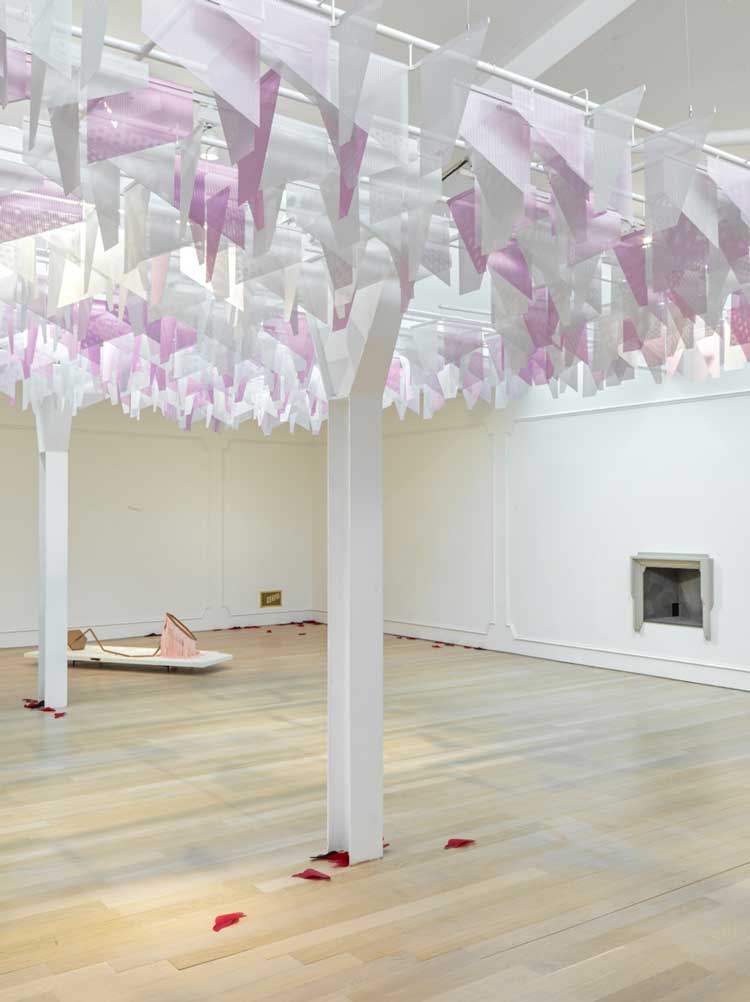
Martin Boyce. Future Blossom (for Yokeno Residence), 2022; Dead Star (Reclining), 2017; Ventilation Grills (for an Apartment Building,) 2003; Somewhere there are Trees, 2022; Same Day, 2015. Installation view, Fruitmarket, Edinburgh, 2024. Photo: Stefan Altenburger.
VS: How did you approach that large, first-floor gallery at the top of the stairs?
MB: There’s a huge sculpture suspended from the ceiling. That room was quite easy in a sense, because in 2022 I had been commissioned by the Museum of Contemporary Art in Toronto to make a new ceiling sculpture as part of a Thomas Demand exhibition. He’d exhibited a suite of photographs, underneath a ceiling piece I made in 2011, which is now owned by the Tate. The ceiling and photographs were shown together in Venice, and then in Belgium, but it became too complicated and expensive to ship it to Toronto. The museum asked if I would consider making a new ceiling piece. I made this huge, suspended ceiling sculpture which uses perforated aluminium fins in white and a couple of shades of pink: it takes the form of futuristic cherry blossom [called Future Blossom (for Yokeno Residence)]. This space in Toronto has these huge concrete pillars, and it’s designed to fit around them. I thought I’d love to show this ceiling piece. But what are the chances it would correspond to the ceiling in Fruitmarket?
My studio manager is also a qualified architect. She does computer-aided design and architectural drawings and plans, and works very closely on installations. We got a plan of the upstairs space of the Fruitmarket, and a plan of the ceiling sculpture, and realised that with a little bit of alteration we could make it work. It was incredibly fortunate. Once we knew we could show that piece, the rest of the room came together quite quickly. There’s a wall moulding I’ve also exhibited before – custom-made wooden mouldings that are applied to the wall and then I’ve painted white. It gives the atmosphere of a huge bourgeois apartment or a grand hallway. And then there’s a fireplace sculpture I was very interested in showing. Also, there’s another door, which is lying horizontally with a lamp that is quite figurative reclining on it. And the fringes are like hair, it’s quite surreal.
In a way it feels like a very complete installation, but the works in it span 2003 to 2022 yet it feels as if they’re all made for each other.
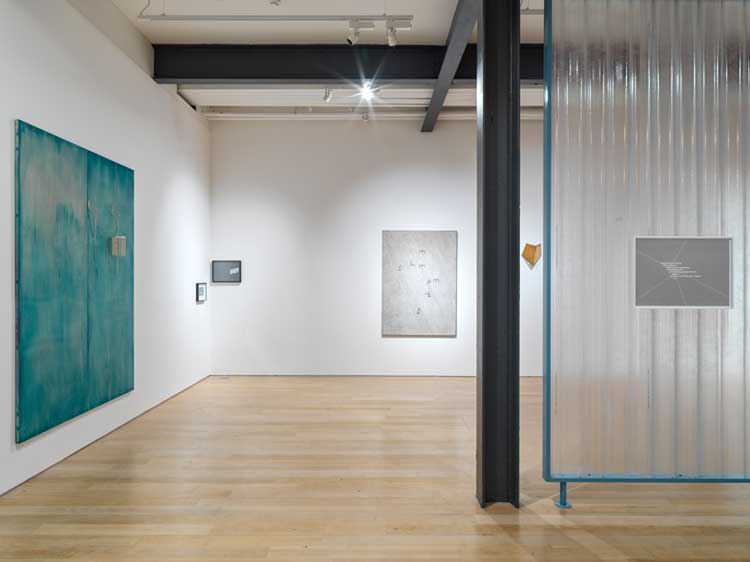
Martin Boyce. Before Behind Between Above Below. Installation view, Fruitmarket, 2024. Photo: Stefan Altenburger.
VS: I am intrigued by how certain works and themes might emerge anew for an artist when pulling together work for a retrospective, given a chance to see them all together.
MB: A few people asked me what it was like to dig out these old works. I have had the experience before where you dig out old pieces from 10 or 20 years ago, and usually it feels like: “OK, here’s someone I recognise but it’s a long time since we spoke.” But I didn’t have that so much this time. It felt like the work was really all existing in the present. There was a deliberate intention to use the work as sculptural elements to create spaces and landscapes and ideas of place rather than present a bunch of autonomous things. It was about using the work in an active way so that they were sort of reactivated in a sense.
VS: Are you pleased with the results?
MB: It’s a real rollercoaster of emotions. You plan what you’re going to do and you’re aware that things might change a little bit, but there are times when you question your decisions. At your lowest, you might even think it’s a disaster and you’re going to have to pretend you like this exhibition. And then, two hours later, you shift something around and you get the lighting right and suddenly it all comes alive again and you’re back to being happy and confident about it all. I find the process really tough. It’s demanding. And, of course, you don’t want the audience to be aware of these things. It looks like it’s all just appeared, magically.
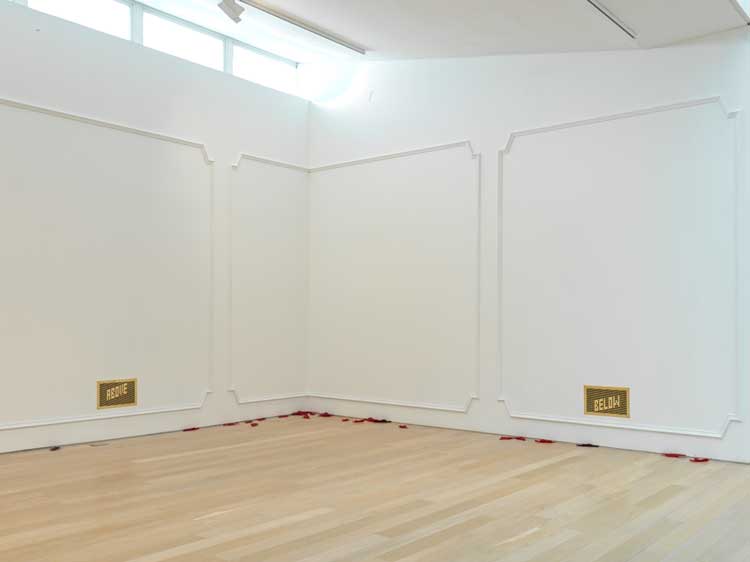
Martin Boyce. Ventilation Grills (for an Apartment Building,) 2003; Somewhere there are Trees, 2022.
Installation view, Fruitmarket, Edinburgh, 2024. Photo: Stefan Altenburger.
It’s also working with a good institution, good people – it really helps. You need that feedback and someone to give you a sense of what they think. Conversation is incredibly important. You make a work and then you make another work and while you’re doing that, you’re still kind of searching for a language that’s yours. You don’t really know what it is that you’re trying to do or what you’re interested in, you’re working from your instincts and impulses. As you accumulate a body of work or bodies of work, it’s easier to then go: “Ah, OK, for some reason I’m drawn to these kinds of things.” And you start to see connections. There’s a series of four photographs called Interiors, which I made in 1992, which are film stills. I think the film was Jagged Edge, not that it matters. I was looking for moments in a film where a character has left the frame or is just about to arrive. So, you just have these empty interiors. Years later, I’m sort of creating interior landscapes or merging interior and exterior landscapes, and you can make a connection between that and the gallery upstairs. Of course, you know you’re in the gallery at the Fruitmarket, but you’re being taken to a number of different places – some grand apartment, and some nod to cherry blossom, and there’s the leaves, so you’re both inside and outside. There’s this push and pull of place.
VS: Even though works might evoke found material or experiences, they’re all constructed.
MB: Very much so. Everything has been sculpted or manipulated. My relationship with the work is funny. If you think about it, I’m working with a fireplace and ventilation grills and leaves, lamps, chairs, doors. It’s like I’m not the author of these objects, because they exist in the world, yet I take these objects and they somehow get filtered through me and then they are defined by the particular sculptural language that I’m involved in … I love the idea of being co-author of the experience. I have a distance from the work. I feel like they’re things you might find either in your imagination or in fiction, or in reality. They have that feeling, but they have to be made. They can’t be found. If I use a chair, it has to be a very particular chair. It’s come through me.
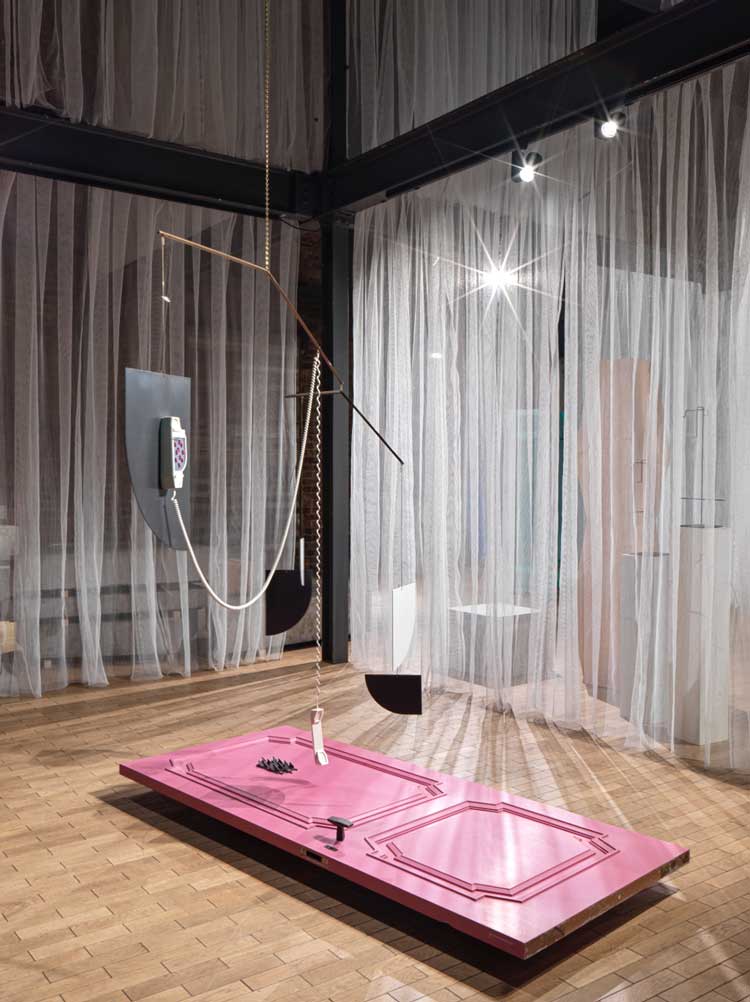
Martin Boyce, Long Distance Sleep Talking, 2022. Installation view, Fruitmarket Warehouse, 2024. Photo: Stefan Altenburger.
VS: There’s a particular emotional charge when you start to use old telephones, as you do in this show.
MB: There are two works that have phones in them: there’s the mobile that is in the warehouse space, it hangs over the pink door, and then there’s a panel with a phone. But those phones are completely designed and made, they’re not found.
I have a huge database of images of things that might be useful, and I had this image of an old Bakelite telephone on a wall, and I kept coming back to it. I didn’t want to use a found telephone, so I started to design a telephone and we found this amazing company in Stirling that does prototyping, with very advanced casting and 3D printing, so we worked together and there have now been three different iterations of the telephones, which are made in resin. But I’ve only been using these in works since 2020.
VS: You showed a version of a phone booth in your Tate show in 2011, and at the time it was described as “an object that’s in the process of disappearing”. In the intervening decade or so, our relationships with phones and communications have gone through several other massive evolutionary shifts. What do you feel an analogue receiver or handset says now as an object, especially to younger audiences that have never used a landline?
MB: Really the impetus was because it felt quite cinematic – this expectation and potential that the phone might ring. But then I started to think what the landline phone was, in relation to digital technology: it’s a room phoning a room, a location phoning another location. It’s fixed. That in itself really interested me. And then when it’s not in use, it’s inanimate, while our mobile phones are constantly active, in our pockets, or on the table. It was a way to think about technology without depicting it. I hate the word retro-futuristic, but in that Blade Runner way it has this kind of futuristic appearance, though, of course, it’s also about the past. They’re like phantoms in that way that we rarely see them.

Martin Boyce. Before Behind Between Above Below. Installation view, Fruitmarket, 2024. Photo: Stefan Altenburger.
VS: You’ve had some interesting commissions for public sculpture over the years. I was admiring the three-part work you made for Galeries Lafayette in Paris. Is this a substantial strand of your work?
MB: It’s something I find I’m really interested in, and these commissions come along every now and again. I don’t find it easy. You would think I could just transfer what I do in the gallery to outside, maybe make it bigger or use a more robust material. But because my work uses the language of the exterior, when you bring it inside, it’s that shift in context that creates this uncanny feeling. It’s very difficult to translate that to an outdoor situation. But it’s something I’m working on all the time.
VS: How big a role does Glasgow play in your work or inspiration? You grew up near there, you studied there and now you live there. It seems Glasgow creates a good base for artists.
MB: I would agree. Artists like to live here and work here, but it’s a bit of a trap as well because there’s not the support structure, the institutional support, there are no collectors, so you can base yourself here and work here and it’s a great city to live in. But everything I do, or most things, are outside the UK. I don’t have a huge presence in London, which I find frustrating sometimes. I’d like to address that. Although Edinburgh and Glasgow are the main cities in Scotland, in terms of the UK you need to have a presence in London.
,-2017-(detail).jpg)
Martin Boyce. Dead Star (Reclining), 2017. Installation view, Fruitmarket, Edinburgh, 2024. Photo: Stefan Altenburger.
VS: I could imagine you would find inspiration every day walking around in Glasgow’s richly layered urban landscape – so many eras and aesthetics, giant motorways next to cobbled streets, squalor and splendour, all side by side.
MB: I would say it is at the core of where the work comes from. It’s somewhere between a kind of intense act of looking and just a state of reverie, of letting it flow through you. I mean, I can think of very specific moments where I’ve caught a glimpse of something and it’s triggered a whole set of ideas, or potentials for a work or an exhibition.
• Martin Boyce: Before Behind Between Above Below is at Fruitmarket Gallery, Edinburgh, until 9 June 2024.